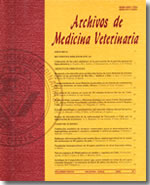Twin induction by transfer of a second embryo ipsilateral or contralateral to the corpus luteum in mated cows
Main Article Content
Abstract
The purpose of this work was to compare the effect of the site of transfer (ipsilateral or contralateral to the corpus luteum) of a second embryo to already mated cows on pregnancy and twinning rate.
Thirty two frozen-thawed embryos were transferred ipsilateral to the corpus luteum of recipient cows and twenty eight were transferred contralaterally.
On the ipsilateral group 21 cows became pregnant after first service (65.6%), while 21 out of 28 recipients were diagnosed as pregnant in the contralateral group (75%). No significant differences were observed between both groups.
Twin pregnancy rate at 60 and 90 days after service was 57.1 and 45% of pregnant recipients for the ipsilateral group and 14.3 and 4.8% for the contralateral group. Significant differences (P< 0.05) were observed between groups at both times.
Although embryos transferred to the ipsilateral horn have higher probabilities to survive when the native embryos are reabsorbed in comparison with the ones transferred to the contralateral horn, we did not observe differences on the pregnancy rate of both groups after first service. The difference we observed in the number of twin pregnancies between groups was higher than that described in the literature. These results confirm the fact that the existence of 2 embryos in one uterine horn does not increase the embryo or foetal mortality rate.
According to our findings we can conclude that the transfer of a second embryo to the ipsilateral uterine horn of already mated cows is a better twin induction technique than contralateral transfers.

